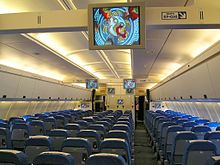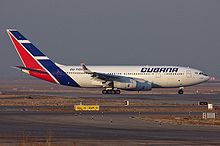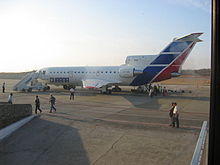- Cubana de Aviación
-
For Russian airline, see Kuban Airlines."Cubana" redirects here. For the country, see Cuba.
Cubana de Aviación 
IATA
CUICAO
CUBCallsign
CUBANAFounded 8 October 1929 Hubs Focus cities Airport lounge Club Tropical Lounge Fleet size 20 (+3 orders) incl. cargo Destinations 35 Company slogan Puerta de Cuba al Mundo
"Cuba's Gateway to the World"Parent company Corporación de la Aviación Civil S.A. (CACSA) Headquarters Havana, Cuba Key people Arturo Bada Álvarez (CEO) Website www.cubana.cu Cubana de Aviación S.A., commonly known as Cubana, is Cuba's largest airline and flag carrier. The airline was founded on 8 October 1929, and has its corporate headquarters in Havana.[1] Its main base is at José Martí International Airport. It was a founder and is a current member of the International Air Transport Association[2] (IATA), the International Association of Aeronautical Telecommunications[3] (SITA) and the International Association of Latin American Air Transportation[3] (AITAL).
Originally a subsidiary of Pan American World Airways (PANAM) and later a private company owned by Cuban investors, Cubana has been wholly owned by the Cuban government since May 1959 and celebrated its 80th anniversary in 2009. The airline has 32 international representatives and 13 offices in Cuba, and its current official name is Cubana de Aviación S.A. It was the first airline of The Americas to operate Russian aircraft.
Contents
History
Main article: History of Cubana de AviaciónCubana was established on 8 October 1929 as Compañía Nacional Cubana de Aviación Curtiss, indicating its association with the Curtiss Robin aircraft manufacturing company. It was one of the earliest airlines to emerge in Latin America. Pan American Airways (then known as Pan American Airways System or PAA) acquired Cubana in 1932, and the word Curtiss was deleted from the airline's name. Cubana therefore became a subsidiary of Pan American Airways. In 1944, the first International Conference on Civil Aviation was convened, which later would lead to the creation of the International Civil Aviation Organization (ICAO, currently based in Montreal, Canada). Cuba was a participant in this conference and a founding member of ICAO. In April 1945, the conference that created the International Air Transport Association (IATA) was held in Havana. Cubana became a founding member of IATA, and participated in the creation of that organization through its involvement with the Havana conference and the resulting accords. Both conferences and the organizations they spawned helped establish Cubana as an internationally recognized airline company.
In May 1945 Cubana started its first scheduled international flights to Miami, using Douglas DC-3 aircraft. Cubana was the first Latin American airline to establish scheduled services to Miami. In April 1948, a transatlantic route was started between Havana and Madrid (via Bermuda, the Azores and Lisbon) using Douglas DC-4 aircraft. The Madrid route was extended to Rome in 1950. The new route to Europe made Cubana one of the earliest Latin American carriers to establish scheduled transatlantic service.
 Cubana Bristol Britannia 318 at Lima Airport, Peru, in 1972
Cubana Bristol Britannia 318 at Lima Airport, Peru, in 1972
In May 1959, the revolutionary government decided to take over Cubana, expropriating all the airline's private investors without compensation. The private passenger airline Aerovías Q and private cargo carriers Cuba Aeropostal and Expreso Aéreo Interamericano, were then merged into Cubana. Despite these problems, in 1961 Cubana expanded its scheduled transatlantic services to Prague (apart from its existing Madrid route) using its Bristol Britannia jet-props. Cubana then ceded one of its Britannias to Czechoslovak Airlines (CSA) so that it could start its own Prague-Havana flights, in cooperation with Cubana's services on that route. Cubana's crews trained CSA personnel in the operation of the Britannias. This allowed CSA to establish its first-ever scheduled transatlantic service in 1962.
With the U.S. breaking relations (in 1961) and the imposition of the U.S. embargo on Cuba (in 1962), Cubana turned to the Soviet Union to obtain new aircraft. Cubana's cooperation made it possible for Aeroflot to establish 18-hour non-stop scheduled services between Moscow and Havana in 1963 which were the longest non-stop flights in the world at that time. Cooperation with the East German airline Interflug made it possible for this carrier to establish its first scheduled transatlantic services, linking East Berlin with Havana.
In the late 1970s, Cuba began operating its own long distance passenger jet services using the Ilyushin Il-62 (first flight in 1963, range of 10,300 km). The Il-62 had been the first plane to be put into long distance jet service by a number of other countries. Cubana operated 28 examples of this airliner between 1979 and 2011, including 11 early version Il-62s and 17 later model Il-62Ms, of which it owned 19 outright, the remaining nine leased either from Aeroflot or the Romanian national airline Tarom. After the 1990s, spare parts for Cubana's Soviet era aircraft became increasingly harder to source. Limited financial resources and lack of Western financing to replace these aircraft coupled with restrictions imposed by the U.S. embargo on the sale of American-built aircraft and components (engines and avionics) made it necessary to keep the Il-62Ms and other Soviet era planes in service despite their age. In the early 2000s Cubana refurbished some of its old Il-62/Il-62Ms to use on international routes (the last two were retired in March 2011) and in 2004, it embarked upon a long-term renovation. The strategy is based on the purchase of $100 million a year in new generation Russian-built aircraft until 2012.[4] By 2012 Cubana will completely replace its old Soviet era aircraft with new generation Russian airliners. As part of its renovation strategy, Cubana has sought to upgrade its technical support capabilities. The airline established a joint venture company with Iberia Airlines of Spain in 2005, to maintain and overhaul Western-built aircraft, including all Airbus and Boeing models. Between 2000 and 2009 Cubana operated services to Iraq but these have since been cancelled. Cubana used to operate services to Asia which was the Latin American airlines to fly normally to Asia. Later, Aeroméxico started services to Narita International Airport in Japan from Tijuana and Mexico City.
 Ilyushin Il-96 economy class interior
Ilyushin Il-96 economy class interior
In December 2005, Cubana received its first Ilyushin Il-96-300, registered CU-T1250. The aircraft made its first official flight in January 2006, covering the Havana - Buenos Aires route. The second Il-96 was received in March 2006 and a confirmation was signed for two additional ones, an Il-96 of the last two orders was received in 2007 and the remaining one is yet to be delivered. Three Tupolev Tu-204 were also ordered in 2006, two passenger version and one cargo version for Cubana Cargo. The Tupolev Tu-204 cargo-version was delivered in August 2007. During the August 2007 MAKS Airshow Cubana signed a $150 million contract for the purchase and confirmation of 2 Tupolev Tu-204 and 3 Antonov An-148 aircraft, to be delivered between 2008 and 2011 and becoming one of the Antonov An-148 launch customers.[5] More orders for new aircraft will be made over the next 7 years until the conclusion of the Russian-Cuban aviation agreements signed in 2006.
Destinations
Cubana operates flights to over 30 destinations in Cuba, Europe, the Caribbean, North, Central and South America.
Further information: Cubana de Aviación destinationsAt July 2011, Cubana has codeshare agreements with the following airlines:
- AeroCaribbean (domestic, Caribbean and Central American destinations)
- Aeroflot (Moscow - Havana)
- Air Europa (Madrid - Havana)
- Blue Panorama Airlines (Rome - Havana)
- Conviasa (Caracas - Havana)
- Copa Airlines (Panama City - Havana)
- Lacsa - Grupo TACA (San Jose, Costa Rica - Havana)
Fleet
The Cubana fleet includes the following aircraft (as of 14 December 2009):[6][7][8][9]
Cubana de Aviación Fleet Aircraft Total Orders Passengers Notes J Y Total Boeing 737-400 2 — — 158 158 leased from Flair Airlines Antonov An-148 — 3 N/a Antonov An-24RV 2 — — 48 48 Replacement aircraft: Antonov 148 ATR 42-500 1 — N/a Operated by Aerogaviota Ilyushin Il-96-300 3 — 18 244 262 CU-T1250, CU-T1251, CU-T1254 Tupolev Tu-204-100E 2 — 12 212 224 CU-T1701, CU-T1702 Tupolev Tu-204-100CE (Cargo) 2 — — — — CU-C1700, CU-C1703[10] Yakovlev Yak-42D 5[11] — — 120 120 CU-T1704, CU-T1272, CU-T1279
CU-T1705, CU-T1255, CU-T1247 [12]Total 17 3 *Business Class is not offered on some short haul flights.
See also
- Cubana Flight 455 - aircraft bombing in 1976
References
- ^ "Directory: World airlines." Flight International. 23-29 March 2004. 59. "Calle 23 Pt 64 Vedado, La Rampa, Havana 4, Cuba"
- ^ IATA - The International Air Transport Association History
- ^ a b "Cubana is a founder and member of the International Association of Aeronautical Telecommunications (SITA) and of the International Association of Latin American Air Transportation (AITAL)". 2005. http://www.cubana.cu/html/ingles/compania_e01.html.
- ^ Cuba last year agreed to buy $100 million a year in civilian aircraft from Russia over the next seven years
- ^ 2007 MAKS Airshow- Cubana signed a $150 million for the delivery of 2 additional Tu-204 and 3 An-148
- ^ Cubana Fleet - Official website
- ^ Cubana Fleet - Airfleets.net
- ^ aerotransport.org: Cubana de Aviación Flotte 19. October 2009
- ^ CH Aviation Cubana Fleet
- ^ http://russianplanes.net/showregistren.php?search=Cubana
- ^ http://russianplanes.net/showregistren.php?search=Cubana
- ^ http://russianplanes.net/showregistren.php?search=Cubana
External links
Members of the International Air Transport Association Africa regional office Air Austral · Air Madagascar · Air Malawi · Air Mauritius · Air Namibia · Air Nigeria · Air Seychelles · Air Zimbabwe · Airlink · ALS · Arik Air · Comair · Ethiopian Airlines · Interair South Africa · Kenya Airways · LAM Mozambique Airlines · Precision Air · Safair · South African Airways · South African Express · TAAG Angola Airlines · TACVAsia-Pacific regional office Air India · Air New Zealand · Air Niugini · Air Pacific · Air Tahiti · Air Tahiti Nui · Air Vanuatu · Aircalin · All Nippon Airways · Asiana Airlines · Bangkok Airways · Biman Bangladesh Airlines · Continental Micronesia · Garuda Indonesia · Japan Airlines · Jet Airways · JetLite · Kingfisher Airlines · Korean Air · Malaysia Airlines · Nippon Cargo Airlines · Pakistan International Airlines · Philippine Airlines · Qantas · Royal Brunei Airlines · SilkAir · Singapore Airlines · Singapore Airlines Cargo · SriLankan Airlines · Thai Airways International · V Australia · Vietnam Airlines · Virgin AustraliaChina and North Asia regional office Air China · Air Koryo · Air Macau · Cathay Pacific · China Airlines · China Cargo Airlines · China Eastern Airlines · China Southern Airlines · Dragonair · EVA Air · Hainan Airlines · Hong Kong Airlines · Hong Kong Express Airways · MIAT Mongolian Airlines · Shandong Airlines · Shanghai Airlines · Shenzhen Airlines · Sichuan Airlines · TransAsia Airways · Xiamen AirlinesEurope regional office Adria Airways · Aegean Airlines · Aer Lingus · Aigle Azur · AirBaltic · Air Berlin · Air Europa · Air France · Air Malta · Air Nostrum · Air One · Alitalia · Arkia Israel Airlines · Atlasjet · Austrian Airlines · B&H Airlines · Belle Air · Binter Canarias · Blue Panorama Airlines · Blue1 · BMI · British Airways · Brussels Airlines · Bulgaria Air · CAL Cargo Air Lines · Cargolux · Carpatair · CCM Airlines · Cimber Sterling · Cirrus Airlines · CityJet · Condor · Corsairfly · Croatia Airlines · Cyprus Airways · Czech Airlines · DHL Air UK · Dubrovnik Airline · El Al · Estonian Air · EuroAtlantic Airways · European Air Transport Leipzig · Eurowings · Finnair · Flybe · Freebird Airlines · Hahn Air · Iberia · Icelandair · Israir Airlines · Jat Airways · KLM · Lauda Air · LOT Polish Airlines · Lufthansa · Lufthansa Cargo · Lufthansa CityLine · Luxair · Malév Hungarian Airlines · Malmö Aviation · Meridiana Fly · Montenegro Airlines · Olympic Air · Onur Air · Pegasus Airlines · Portugália · Scandinavian Airlines · SATA Air Açores · Sky Airlines · Skyways · Spanair · SunExpress · Swiss International Air Lines · TAP Portugal · TAROM · THY Turkish Airlines · TNT Airways · TUIfly · Virgin Atlantic Airways · White Airways · WiderøeLatin America and the Caribbean regional office Aerolíneas Argentinas · Aeroméxico · Air Jamaica · Austral Líneas Aéreas · Avianca · Caribbean Airlines · Copa Airlines · Copa Airlines Colombia · Cubana de Aviación · Lacsa · LAN Airlines · LAN Argentina · LAN Cargo · LAN Ecuador · LAN Perú · MasAir · PLUNA · Surinam Airways · TACA Airlines · TACA Peru · TAM Airlines · TAM Airlines (Paraguay) · TAME · Volaris · VRG Linhas Aéreas S.A.Middle East and North Africa regional office Afriqiyah Airways · Air Algérie · DHL International Aviation ME · EgyptAir · Emirates · Etihad Airways · Gulf Air · Iran Air · Iran Aseman Airlines · Jazeera Airways · Jordan Aviation · Kam Air · Kish Air · Kuwait Airways · Libyan Airlines · Mahan Air · Middle East Airlines · Nouvelair · Oman Air · Qatar Airways · Royal Air Maroc · Royal Jordanian · Safi Airways · Saudi Arabian Airlines · Sudan Airways · Syrian Air · Tunisair · Wataniya Airways · YemeniaNorth America regional office Russia and the CIS regional office Aeroflot · Aerosvit Airlines · Air Astana · Air Moldova · Armavia · Azerbaijan Airlines · Belavia · Donavia · Georgian Airways · Nordavia · Rossiya · S7 Airlines · Transaero Airlines · Ukraine International Airlines · UTair Aviation · Vladivostok Air · Volga-Dnepr AirlinesCategories:- Airlines established in 1929
- Airlines of Cuba
- Government-owned airlines
- IATA members
- Latin American and Caribbean Air Transport Association
Wikimedia Foundation. 2010.



